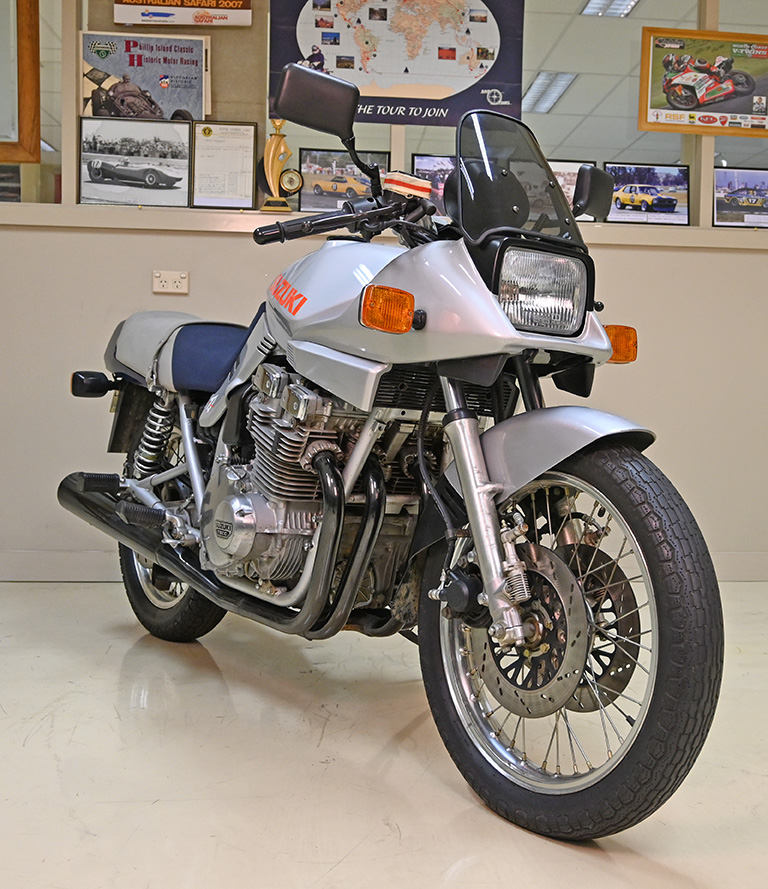Motorcycle Investor mag
Subscribe to our free email news

Suzuki 6-Hour Special Katana
by Guy ‘Guido’ Allen, May 13 2021

Rare wire-wheeled variant never made it to the track
It’s not quite up there with the appearance of a Loch Ness monster, but for an air-cooled Suzuki nut, it’s a close second – that is, the emergence on the market of a low-mile pukka wire-wheel Katana 1100 with a known history.
It’s been in the hands or auto racing identity Bryan Thomson since new and he’s now decided to let go of this and a few other toys.

This model summary penned by motorcycle historian Ian Falloon gives an overview:
When Suzuki embarked on their Katana in 1979, they engaged Hans A Muth’s Target Design to draw up their Katana.
Muth and fellow Target Design directors Hans Georg Kasten and Jan Olof Fellström presented Suzuki with a radical design created through wind tunnel testing.
The rider and motorcycle were incorporated as a complete aerodynamic package, with the fairing and fuel tank flowing air over and around the rider. The first prototype appeared in April 1980, with an official unveiling a few months later at the Cologne show.
To everyone’s surprise Suzuki announced the Katana (named after a Samurai sword) would go into production during 1981, and so it did, for the 1982 model year.

The air-cooled 1074cc four-cylinder engine had double overhead camshafts, four valves per cylinder, and Suzuki’s TSCC (Twin Swirl Combustion Chamber) but was still an evolution of an earlier design. Itproduced a class-leading 111 horsepower at 8500rpm.
However, the chassis lagged behind the engine as beneath the style was a twin shock rear end, skinny front forks (albeit with trendy hydraulic anti-dive), and a 19-inch front wheel.
The wheelbase stretched 1520mm and the weight was a considerable 232kg. Intent on winning the 1981 Castrol 6-Hour race at Amaroo Park, Suzuki Australia ordered 100 6-Hour Specials. These were fitted with 19 and 18-inch wire wheels from the Canadian-spec version.
The 18-inch wheel was preferred for racing as there was a wider range of tyres available and the lower sidewall didn’t flex as much as the 17-inch. But with the shipment stranded off Sydney heads due to a tugboat strike the Katana missed the cut-off date for race entry and the wire-wheeled Katana didn’t actually race in the 6-Hour that year.
Ironically Suzuki still won the 1981 Castrol Six-Hour race; with a GSX1100 shod with a 17-inch rear wheel!
***

This example claims under 3700km on the odo. It's being auctioned by Donington Auctions in Australia with an estimate of Au$30-40,000 (US$23-31,000, GB£16-22,000). The auction concludes June 20.
***
Ed’s note: The 6-Hour Specials are different to though sometimes confused with the GSX1100SXZ E27 specials built for South Africa and New Zealand, plus the more widely-available GSX1000-based Katana racers. The latter two were much closer to being homologation race specials, with differences that included (depending on variant) forged pistons, welded cranks and slide rather than CV carburettors, and brake spec.
Australian 6-Hour Specials were standard Katana 1100s, aside from the wheels and minor trim such as the 'suede' finish on the seat covers.
More
1981 Castrol 6-Hour results
1981 Suzuki GSX1100 Katana specs
Our Katana
-------------------------------------------------
Produced by AllMoto abn 61 400 694 722
Privacy: we do not collect cookies or any other data.

Archives
Contact





